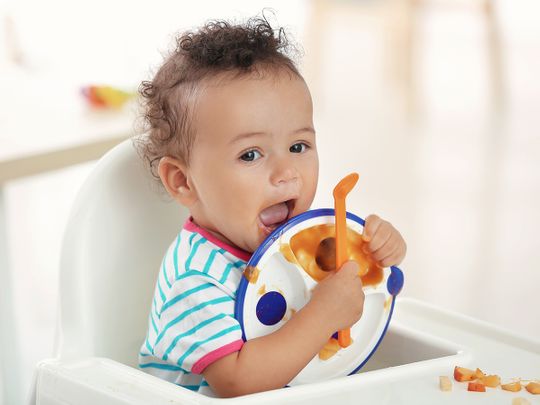
Introducing your baby to a world of food is an exciting time but it can also feel quite daunting; no sooner have you started to master milk feeds and it’s all change again! These three simple principles can start you off on the road to success…
1) Start at the right time
The World Health Organisation advise introducing complementary foods at around six months, alongside your baby’s usual breast milk or formula milk. Babies naturally develop the skills they need to move on to solid food, and these signs tend to appear around the six-month mark.
All babies are unique and will develop at different rates. If you feel your baby is ready slightly before the six months mark (and they are showing the key signs that indicate they are ready) then it’s absolutely fine to offer some first taste purees slightly earlier (just not before 17 weeks as a baby’s digestive system and kidneys might not be developed enough to cope with solids before this point).
So, how can you tell if your baby is developmentally ready to start sampling some simple solids? There are a few key signs to look out for:
• Sitting-up and supporting their head in a stable position
They need to be able to stay seated in a sitting position without intervention.
• Hand-to-eye coordination
They need to be able to coordinate food and direct it into their mouth.
• The tongue-thrust reflex has disappeared
Once they have lost this reflex (usually around 6 months) they will be better able to move food from the front to the back of their mouth and swallow it.
2) Go Slow
Once you’re ready to start offering your baby those very first tastes, you need to first be aware that weaning is a gradual process and they will only be having very small amounts (roughly 2 – 3 spoonfuls). Babies have tiny tummies and their usual milk will still be acting as their main source of nutrition in these early stages. These initial tastes are more about food exploration and learning the art of eating.
So, what foods to start with? I would suggest beginning with a single vegetable. This means that your baby can identify the foods they’re eating. Once they have accepted these single flavours, you can then go on to combine flavours and introduce fruit before moving on to nutrient dense foods containing iron-rich protein and omega 3 essential fatty acids from meat, fish, eggs and lentils for example.
Depending on whether you are opting for a spoon-led or baby led approach to weaning, when it comes to food prep, you can simply steam and blend (or use a sieve and fork) if offering purees so that the consistency is smooth and lump-free. And if you’re going down the baby-led route, then you’ll need to steam or bake the vegetables so that they are nice and soft, but not so soft that they can be easily mushed – that baby grip is stronger than you think!
3) Develop a routine
You’ll probably already have a routine in place for your baby and family and weaning will naturally fit into this.
You’ll want your baby to be alert, as learning this new skill will take full concentration, so I would recommend offering them new foods after they’ve had a nap, but not directly before. You want to try and find that sweet spot where your baby isn’t overly hungry but not too full either. If your baby is anxious for (and expecting) a milk feed and you offer a spoonful of puree or a soft vegetable chunk, your baby might become confused and frustrated.
Mid-morning or lunchtime tends to work well for lots of families. You could introduce their first taste of solids at their mid-morning feed or after giving your baby a shorter milk feed first. This also means you have the whole day to monitor your baby in the unlikely event they have an allergic reaction to certain foods.
Read more:








